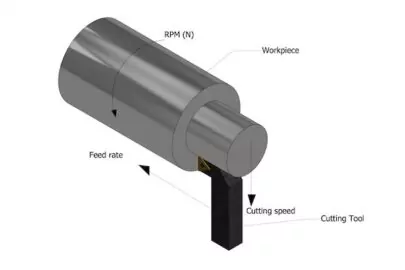In the world of precision machining, CNC turning operations play a pivotal role in crafting highly accurate and functional components. From simple cylindrical parts to intricate geometries, these operations transform raw materials into finished products that meet exact specifications.
Understanding the different types of CNC turning processes is crucial for selecting the right technique for your project. This guide explores 10 common CNC turning operations, highlighting their features, benefits, and applications. Whether you’re a manufacturer or engineer, this comprehensive breakdown will help you make informed decisions.
What is CNC Turning?

CNC turning is a machining process where a workpiece is rotated while a cutting tool removes material to create the desired shape. The term “CNC” refers to Computer Numerical Control, where computerized systems precisely manage the movement of the cutting tools. This ensures high accuracy, repeatability, and production efficiency.
CNC turning is widely used in industries such as aerospace, automotive, and medical manufacturing. It offers unparalleled precision for producing everything from simple components to complex, high-tolerance parts, making it indispensable in modern manufacturing. Additionally, it enhances productivity by allowing for rapid production of intricate designs.
Types of CNC Turning Operations

CNC turning encompasses a wide range of techniques, each suited for specific tasks. Below, we delve into 10 key operations, explaining their features and applications.
Threading
Threading involves cutting helical grooves, or threads, into the surface of a cylindrical workpiece. These threads are used for fasteners or connections, such as bolts and nuts.
Features:
- Produces internal or external threads.
- Can create metric or imperial thread profiles.
- Precision threading tools ensure consistent pitch and depth.
Applications: Threading is essential in industries like automotive and construction, where threaded components are integral to product assembly. It also finds use in pipe systems for secure, leak-proof connections and in the manufacturing of screws, studs, and similar fastening elements.
Tapping
Tapping is similar to threading but specifically involves creating internal threads within a hole. This process prepares the workpiece for screws or bolts to be inserted.
Features:
- Achieves precise thread sizes for various fasteners.
- Suitable for materials like metal, plastic, or composite.
Applications: Tapping is commonly used in machinery and electronics for creating secure connections in assemblies. It is also critical in the manufacturing of products where threaded holes must align perfectly with corresponding parts, such as casings and frames.
Turning
Turning is the most fundamental CNC turning operation, where the cutting tool removes material to produce a cylindrical shape.
Features:
- Can create straight, tapered, or contoured surfaces.
- Offers high precision for both external and internal surfaces.
Applications: Turning is ideal for producing shafts, bushings, and other cylindrical components. It plays a vital role in creating core parts for engines, turbines, and various mechanical systems.
Facing
Facing involves cutting across the end of the workpiece to produce a flat surface perpendicular to its axis.
Features:
- Ensures precise length and surface finish.
- Prepares workpieces for further machining, such as drilling or threading.
Applications: Facing is widely used in the preparation of parts like flanges, gears, and pulleys. It also ensures smooth, even surfaces for assembly in precision components used in complex machinery.
Boring
Boring enlarges an existing hole or cavity within the workpiece. It ensures accurate diameter and alignment for internal features.
Features:
- Achieves tight tolerances for internal diameters.
- Used for both concentric and eccentric holes.
Applications: Common in automotive and aerospace industries for engine components and hydraulic systems. It is crucial in making bearing seats, precise internal profiles, and alignment-critical parts.
Drilling
Drilling involves creating holes along the workpiece’s axis using a rotating cutting tool.
Features:
- Can produce holes of varying diameters.
- High-speed drilling ensures efficiency in mass production.
Applications: Used for producing holes in components like engine blocks, brackets, and panels. Drilling also facilitates the assembly of larger systems by providing necessary openings for fasteners, pins, or additional components.
Grooving
Grooving cuts narrow channels into the workpiece’s surface. These grooves can be either internal or external.
Features:
- Precise control over groove depth and width.
- Creates features for retaining rings or seals.
Applications: Grooving is essential in hydraulic systems and sealing applications. It also plays a critical role in producing keyways and slots for mechanical couplings, ensuring that parts fit securely and function reliably.
Knurling
Knurling produces a textured pattern on the workpiece’s surface to improve grip.
Features:
- Creates cross-hatched, straight, or angled patterns.
- Enhances functionality and aesthetics.
Applications: Used in tools, handles, and control knobs to improve user interaction. Knurling also enhances the visual appeal of consumer products, especially in high-end manufacturing.
Parting
Parting, or cut-off, separates a finished component from the workpiece.
Features:
- Ensures clean separation with minimal waste.
- Precision tools prevent damage to the finished part.
Applications: Common in high-volume production to streamline the machining process. It is frequently used in manufacturing individual components like gears, rings, and other smaller parts efficiently.
Reaming
Reaming enlarges and refines the finish of a pre-drilled hole.
Features:
- Improves dimensional accuracy and surface quality.
- Ideal for achieving precise fit for pins or shafts.
Applications: Used in applications requiring high-precision holes, such as engine assembly and tooling. Reaming ensures a smooth, accurate finish for tight tolerances, particularly in critical machinery components.
The Future of CNC Turning Operations

With advancements in technology, CNC turning operations are becoming more efficient and versatile. Innovations such as multi-tasking CNC machines integrate turning with other processes like milling and drilling, reducing setup time and improving productivity. Additionally, the use of AI-powered tools for real-time monitoring and predictive maintenance helps ensure consistent quality and prolongs machine lifespan.
For businesses looking to stay competitive, these advanced solutions provide a significant edge, enabling faster turnaround times and superior results across a wide range of industries.
Expanding the Scope: Advanced Features and Automation
In modern CNC turning, advanced features such as multi-axis capabilities and live tooling allow for more complex operations without repositioning the workpiece. Automation through robotic arms and bar feeders enhances efficiency and reduces production time, making CNC turning a preferred choice for mass production.
Emerging technologies, including real-time monitoring and adaptive controls, help optimize operations by adjusting cutting parameters based on the material’s response. These innovations reduce waste, prolong tool life, and ensure consistent quality.
By mastering these CNC turning operations, manufacturers can address a wide array of machining needs, from simple cylindrical parts to complex components with intricate geometries.
Key Considerations for CNC Turning Operations

When selecting a CNC turning operation, several factors should be considered to ensure optimal results:
Material Type
One of the most critical aspects of CNC turning is understanding how the material being machined will respond to the process. Different materials require different approaches, and the choice of cutting tools, speed, and feed rates will vary accordingly.
For instance, metals like aluminum are lightweight and have good machinability, allowing for faster cutting speeds and lower tool wear. This makes aluminum ideal for high-volume applications in industries like aerospace and automotive. Steel, on the other hand, offers greater strength and durability but may require slower machining speeds and more robust tooling to handle its hardness. High-carbon or alloy steels, in particular, may necessitate the use of specialized cutting fluids to manage heat and prolong tool life.
Meanwhile, plastics and composites pose a different set of challenges. These materials often require lower cutting speeds to avoid melting or deforming. Additionally, specialized tools with sharp cutting edges and high rake angles may be necessary to produce clean, burr-free edges. Choosing the right tool and machining parameters is essential for avoiding issues such as chipping or warping, which can compromise the part’s functionality.
Part Complexity
The complexity of the part being manufactured will also dictate the type of CNC turning operation required. Simple cylindrical components, such as rods or shafts, can be efficiently produced using basic turning processes. However, more intricate designs may demand advanced operations like threading, grooving, or knurling to achieve specific functional or aesthetic features.
For example, internal and external threading operations are often used to create components that need to be screwed together, such as bolts and nuts. These operations require precise control over tool positioning to ensure the threads match their intended counterparts. Similarly, grooving operations are crucial for parts that must accommodate O-rings or retaining clips, as they create the necessary channels for these features.
Additionally, complex geometries may benefit from multi-axis CNC lathes, which allow for simultaneous movement of the workpiece and cutting tool in multiple directions. This capability can significantly reduce setup time and improve the accuracy of parts with intricate contours or multiple features.
Production Volume
The production volume of a project can heavily influence the choice of CNC turning operations. For high-volume production, operations like turning and drilling are particularly well-suited, as they can be easily automated for maximum efficiency. CNC lathes equipped with bar feeders or automatic tool changers further enhance productivity by reducing downtime between operations.
In contrast, low-volume or custom projects often prioritize precision over speed. Operations like boring or reaming, which are used to refine internal diameters or achieve tight tolerances, may be more appropriate for these scenarios. Although these processes can be slower, they ensure the high-quality finish and accuracy required for bespoke or prototype parts.
Tolerances and Surface Finish
Certain industries, such as medical and aerospace, demand components with exceptionally tight tolerances and superior surface finishes. In these cases, the choice of CNC turning operation becomes even more critical.
Reaming is an excellent operation for achieving precise hole diameters and smooth internal finishes. It is often used as a follow-up to drilling, where the initial hole is brought to its final size with minimal material removal. Similarly, threading operations are essential for applications requiring secure and reliable fastening, where even slight deviations in thread pitch or depth can compromise performance.
Surface finish is another important consideration. Facing operations, for example, are used to create flat, smooth surfaces on the ends of cylindrical parts. This is essential in applications where the part will interface with other components, and a poor surface finish could lead to issues such as improper sealing or increased wear.
Machine Capabilities
The capabilities of the CNC lathe itself are a crucial factor in determining the appropriate turning operations. Modern CNC machines offer a variety of advanced features that can expand the range of possible operations and improve overall efficiency.
For instance, multi-axis CNC lathes allow for complex parts to be machined in a single setup by enabling simultaneous movement in multiple directions. This not only reduces the need for manual repositioning but also improves the accuracy and consistency of the finished part.
Live tooling is another valuable feature found in some CNC lathes. It allows for additional operations, such as milling or drilling, to be performed without removing the workpiece from the lathe. This is particularly useful for parts requiring features like slots, holes, or keyways, as it eliminates the need for secondary machining processes and reduces overall production time.
Finally, programmability and software integration play a significant role in modern CNC machining. Advanced CAD/CAM systems enable precise programming of tool paths and machining parameters, ensuring optimal performance for even the most complex operations. These systems also facilitate quick adjustments and easy replication of machining programs, which is invaluable for high-volume or repeat production runs.
Conclusion
CNC turning operations are integral to precision machining, offering a wide range of techniques to meet diverse manufacturing needs. From threading and tapping to facing and boring, each operation plays a critical role in producing high-quality components with efficiency and accuracy.
For businesses seeking expert machining services, Zintilon stands out as a reliable partner. With years of experience in CNC turning, Zintilon delivers tailored solutions for industries like automotive, aerospace, and medical manufacturing. Their cutting-edge technology and skilled workforce ensure top-tier results, helping clients meet their production goals with confidence. Trust Zintilon for your next project and experience the difference in quality and service.
Great, Together



